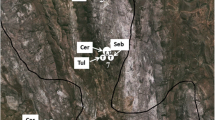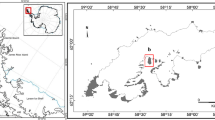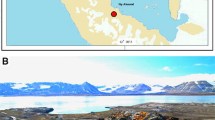Abstract
Bryophytes comprise one of the richest microfungal microhabitats in the Antarctic environment. The maritime Antarctic is very vulnerable to rapid environmental change caused by global warming. The aim of this study was to investigate the importance of bryophytes as a microhabitat for fungal species in the maritime Antarctic by surveying endophytic fungal diversity from several bryophytes including Andreaea sp., Barbilophozia hatcheri, Chorisodontium aciphyllum, Polytrichum alpinum, Polytrichum strictum, Sanionia uncinata, and Warnstorfia sarmentosa. We collected 13 bryophyte samples at four localities on Barton Peninsula, King George Island. In total, 31 endophytic fungi morphotypes were isolated from bryophyte tissues by a thorough surface sterilization method. Using internal transcribed spacer sequence analysis, 16 endophytic fungal strains belonging to Ascomycota (12), Basidiomycota (1), Oomycota (1), and Zygomycota (2) phyla were obtained. Our results suggest the presence of a diverse range of fungal species even in a very limited area, and those bryophytes play an important role in conserving fungal diversity in this harsh environment. Growth rate measurements at a wide range of temperatures confirmed that most of the fungal strains were both mesophilic and psychrotolerant. This is the first report of endophytic fungi in Antarctic moss tissue by fluorescence in situ hybridization.



Similar content being viewed by others
References
Bailey AD, Wynn-Williams DD (1982) Soil microbiological studies at Signy Island, South Orkney Island. Br Antarct Surv Bull 51:167–191
Baschien C, Manz W, Neu TR, Marvanova L, Szewzyk U (2008) In situ detection of freshwater fungi in an Alpine stream by new taxon-specific fluorescence in situ hybridization probes. Appl Environ Microbiol 74(20):6427–6436. doi:10.1128/AEM.00815-08
Baublis JA, Wharton RA, Volz PA (1991) Diversity of micro-fungi in an Antarctic Dry Valley. J Basic Microbiol 31(1):3–12
Boyd WL, Staley JT, Boyd JW (1966) Ecology of soil microorganisms of Antarctica. Antarct Res 8:125–159
Bradner JR, Sidhu RK, Yee B, Skotnicki ML, Selkirk PM, Nevalainen KMH (2000) A new microfungal isolate, Embellisia sp., associated with the Antarctic moss Bryum argenteum. Polar Biol 23:730–732
Bridge PD, Denton GJ (2007) Isolation of diverse viable fungi from the larvae of the introduced chironomid Eretmoptera murphyi on Signy Island. Polar Biol 30:935–937
Caretta G, Frate GD (1990) Fungi isolated from Antarctic material. Polar Biol 11:1–7
Caretta G, Frate GD, Mangiarotti AM (1994) A record of Arthrobotrys tortor Jarowaja and Engyodontium album (Limber) de Hoog from Antarctica. Bol micol 9:9–12
Davey ML, Currah RS (2006) Interactions between mosses (Bryophyta) and fungi. Can J Bot 84:1509–1519
Dőbbeler P (1997) Biodiversity of bryophilous ascomycetes. Biodivers Conserv 6:721–738
During HJ, Van Tooren BF (1990) Bryophyte interactions with other plants. Bot J Linn Soc 104(1–3):79–98. doi:10.1111/j.1095-8339.1990.tb02212.x
Ellis-Evans JC (1985) Fungi from maritime Antarctic freshwater environments. Br Antarct Surv Bull 68:37–45
Ellis-Evans JC, Walton D (1990) The process of colonization in Antarctic terrestrial and freshwater ecosystems. Polar Biol 3:151–163
Fletcher LD, Kerry EJ, Weste GM (1985) Microfungi of Mac. Robertson and Enderby Lands, Antarctica. Polar Biol 4:81–88
Gamundi IJ, Spinedi HA (1988) Ascomycotina from Antarctica: new species and interesting collections from Danco Coast, Antarctic Peninsula. Mycotaxon 33:467–482
Grasso SJM, Scheirer DC (1981) Scanning electron microscopic observations of a moss-fungus association. Bryologist 84(3):348–350
Heal OW, Bailey AD, Latter PM (1967) Bacteria, fungi and protozoa in Signy Island soils compared with those from a temperate moorland. Phil Trans Roy Soc Lond B Biol Sci 252:191–197
Higgins KL, Arnold AE, Miadlikowska J, Sarvate SD, Lutzoni F (2007) Phylogenetic relationships, host affinity, and geographic structure of boreal and arctic endophytes from three major plant lineages. Mol Phylogenet Evol 42(2):543–555. doi:10.1016/j.ympev.2006.07.012
Hoshino T, Tojo M, Okada G, Kanda H, Ohgita S, Ishizaki K (1999) A filamentous fungus, Pythium ultimum Trow var. ultimum, isolated from moribund moss colonies from Svalbard, northern islands of Norway. Polar Biosci 12:68–75
Hoshino T, Xiao N, Tkachenko OB (2009) Cold adaptation in the phytopathogenic fungi causing snow molds. Mycoscience 50:26–38
Jakucs E, Naar Z, Szedlay G, Orban S (2003) Glomalean and septate endophytic fungi in Hypopterygium mosses (Bryopsida). Cryptogam Mycol 24(1):27–37
Kanda H, Komárková V (1997) Antarctic terrestrial ecosystems. In: Wielgolaski FE (ed) Ecosystems of the World 3 Polar and Alpine Tundra. Elsevier, Amsterdam, pp 721–761
Kauserud H, Mathiesen C, Ohlson M (2008) High diversity of fungi associated with living parts of boreal forest. Can J Bot 86:1326–1333
Knox JS, Paterson RA (1973) The occurrence and distribution of some aquatic phycomycetes on Ross Island and The Dry Valleys of Victoria Land, Antarctica. Mycologia 65(2):373–387
Lee JS, Lee HK, Hur JS, Andreev M, Hong SG (2008) Diversity of the lichenized fungi in King George Island, Antarctica, revealed by phylogenetic analysis of partial large subunit rDNA sequences. J Microbiol Biotechnol 18(6):1016–1023
Li WC, Zhou J, Guo SY, Guo LD (2007) Endophytic fungi associated with lichens in Baihua mountain of Beijing, China. Fungal Divers 25:69–80
Mőller C, Dreyfuss MM (1996) Microfungi from Antarctic lichens, mosses and vascular plants. Micologia 88(6):922–933
Montemartini-Corte A (1991) Funghi di ambienti acquatici. In: Proceedings of the 1st meeting on biology in Antarctica, pp 67–79
Narisawa K, Tokumasu K, Hashiba T (1998) Suppression of clubroot formation in Chinese cabbage by the root endophytic fungus, Heteroconium chaetospira. Plant Pathol 47(2):206–210
Narisawa K, Kawamata H, Currah RS, Hashiba T (2002) Suppression of Verticillium wilt in eggplant by some fungal root endophytes. Eur J Plant Pathol 108:103–109
Onofri S, Tosi S, Persiani AM, Maggi O, Riess S, Zucconi L (1994) Mycological researches in Victoria Land terrestrial ecosystems. In: Battaglia B, Bisol PM, Varotto V (eds) Proceedings of the 2nd meeting on biology in Antarctica. Padova, Italy, pp 19–32
Øvstedal DO, Lewis-Smith RI (2002) Lichens of Antarctica and South Georgia: a guide to their identification and ecology. Arctic 55(2):109–213
Pugh GJF (1980) Strategies in fungal ecology. Trans Br Mycol Soc 75(1):1–14
Pugh GJF, Allsopp D (1982) Microfungi on Signy Island, South Orkney Islands. Br Antarct Surv Bull 21:79–94
Ruisi S, Barreca D, Selbmann L, Zucconi L, Onofri S (2007) Fungi in Antarctica. Rev Environ Sci Biotechnol 6:127–141. doi:10.1007/s11157-006-9107-y
Siciʼnski J, Jażdżewski K, Broyer CD, Presler P, Ligowski R, Nonato EF, Corbisier TN, Petti MAV, Brito TAS, Lavrado HP, Błażewicz-Paszkowycz M, Pabis K, Jażdżewska A, Campos LS (2011) Admiralty bay benthos diversity—a census of a complex polar ecosystem. Deep Sea Res Pt II 58:30–48
Tamura K, Peterson D, Peterson N, Stecher G, Nei M, Kumar S (2011) MEGA5: molecular evolutionary genetics analysis using maximum likelihood, evolutionary distance, and maximum parsimony methods. Mol Biol Evol 28:2731–2739
Tosi S, Casado B, Gerdol R, Caretta G (2002) Fungi isolated from Antarctic mosses. Polar Biol 25:262–268. doi:10.1007/s00300-001-0337-8
Tubaki K, Asano I (1965) Additional species of fungi isolated from Antarctic materials. JARE. 1956–1962 Sci Rep Ser E 27:1–12
Upson R, Read DJ, Newsham KK (2007) Widespread association between the ericoid mycorrhizal fungus Rhizoscyphus ericae and a leafy liverwort in the maritime and sub-Antarctic. New Phytol 176(2):460–471. doi:10.1111/j.1469-8137.2007.02178.x
U’ren JM, Lutzoni F, Miadlikowska J, Arnold AE (2010) Community analysis reveals close affinities between endophytic and endolichenic fungi in mosses and lichens. Microb Ecol 60:340–353. doi:10.1007/s00248-010-9698-2
Vishniac HS (1993) The microbiology of Antarctic soils. In: Friedmann EI (ed) Antarctic microbiology. Wiley, New York, pp 297–341
White TJ, Bruns TD, Lee SB, Taylor JW (1990) Amplification and direct sequencing of fungal ribosomal RNA genes for phylogenetics. In: Innis MA, Gelfand DH, Sninsky JJ, White TJ (eds) PCR protocols: a guide to methods and application, pp 315–322
Wynn-Williams DD (1996) Antarctic microbial diversity: the basis of polar ecosystem processes. Biodivers Conserv 5:1271–1293
Zhang T, Zhang YQ, Liu HY, Wei YZ, Li HL, Su J, Zhao LX, Yu LY (2013) Diversity and cold adaptation of culturable endophytic fungi from bryophytes in the Fildes Region, King George Island, maritime Antarctica. FEMS Microbiol Lett 341:52–61
Acknowledgments
This work was supported by grants from the Korea National Research Resource Center Program and the Korean Polar Research Institute (KOPRI, PE13030).
Author information
Authors and Affiliations
Corresponding author
Electronic supplementary material
Below is the link to the electronic supplementary material.
Rights and permissions
About this article
Cite this article
Yu, N.H., Kim, J., Jeong, MH. et al. Diversity of endophytic fungi associated with bryophyte in the maritime Antarctic (King George Island). Polar Biol 37, 27–36 (2014). https://doi.org/10.1007/s00300-013-1406-5
Received:
Revised:
Accepted:
Published:
Issue Date:
DOI: https://doi.org/10.1007/s00300-013-1406-5




